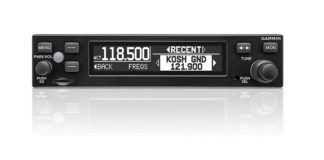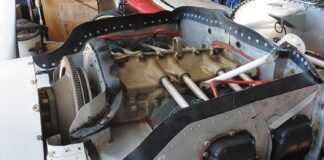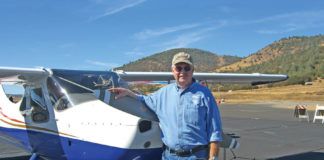Valve sticking, also called morning sickness because it often shows up at the first engine start, is the result of reduced valve stem to valve guide clearance syndrome.
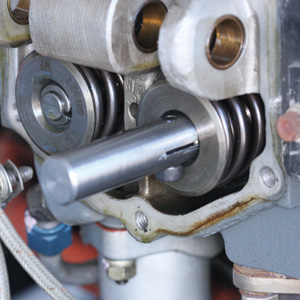
This is not new. During the mid-1960s, Lycoming increased the valve stem size (from 7⁄16 to 1⁄2 inch) and, beginning in the mid-1990s, also replaced the original bronze valve guides with Hi-Chrome guides to improve wear characteristics. All engines, cylinder kits and piece parts shipped by Lycoming since March 1998 have had these new guides. Still, some Lycoming engines suffer from sticking valves, especially engines with the old-style guides.
Valve sticking comes from excessive clearance between the valve stem and guide, which introduces contaminants into the guide and can promote cocking of the valve in the guide; when the valve doesn’t seat squarely, trouble begins.
There’s an SB for That
Lycoming’s service bulletin 388C says that valve-guide wear (bell-mouthing) occurs on the inside diameter of the valve guide in a straight line with the centerline of the rocker arm. Valve-stem movement must be measured by moving the valve stem along this line. Service bulletin 388C recommends that valve-to-guide clearance checks be done every 330 hours on Lycoming engines installed in helicopters, and every 440 hours for fixed-wing aircraft.
According to service instruction 1485A, these inspection intervals increase to 1000 hours when Hi-Chrome guides are installed on all cylinders. Lycoming cylinders with Hi-Chrome guides have a small C inside a circle stamped on the boss above the oil drainback tube fitting.
In addition to the service bulletin that describes methods for checking the valve-to-guide clearance (SB 388C), there’s also one that describes methods that can be used for reaming the valve guides back to size (SI 1425A) without removing the cylinder from the engine. All of these documents are available from Lycoming as PDFs.
Service Bulletin 388C
This bulletin details three methods for conducting valve wobble checks. After removing the valve actuating parts, a gage (Lycoming spelling) adapter is installed on the top of the valve stem. This gage adapter acts as an extension of the valve stem. Then a fixture is put in place, secured using valve-cover screws.
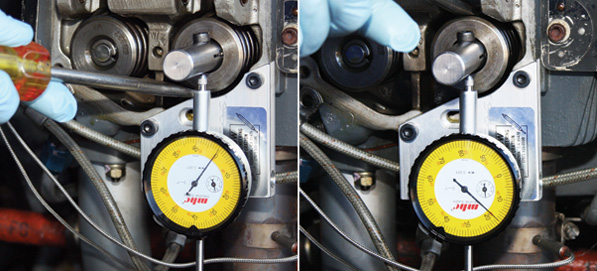
Where do you get the fixture? Lycoming sells it as part number ST-71, list price $550 for parallel-valve cylinders, and ST-310, list price $1709 for angle-valve cylinders. If you’re put off by the price of the Lycoming tools and you’re not a machinist, don’t despair. There’s still a relatively inexpensive way to get your hands on the tools needed for these tests. Aircraft Spruce sells a fixture (p/n 12-21500) that will work on both angle-valve and parallel-valve cylinders for less than $150 if you already have a dial indicator, or less than $200 with a brand new dial indicator (part number 12-21505).
Back to the process. The exhaust valve is then pushed toward the exhaust port by applying force to the valve-spring retainer with a flat-blade screwdriver, and a set screw on the fixture is turned in and out until a 0.010-inch feeler gage just slides between the set screw and the gage adapter. Then force is applied to the opposite side of the valve-spring retainer to push the valve the other way, and the distance between the set screw and the gage adapter is again measured with feeler gages. The 0.010-inch starting measurement is subtracted from the second measurement to get the measured stem movement, and this value is compared to a chart in the service bulletin.
Part 2 describes another testing method using a Go/No-Go gage. This method requires that the exhaust valve be dropped down into the cylinder bore-details for this procedure are in SI 1425A-before running the gage the full length of the valve guide. The last part of the service bulletin describes an alternate method of performing the test using tools you make yourself-with detailed drawings and materials listings for the construction of these tools.
The Rope Trick
Lycoming Service Instruction 1425A describes how to drop a valve down into the cylinder, ream the guide in place and then reinstall the valve, valve operating mechanism and hardware. In the initial telling this sounds impossible, but it isnt. All thats required is patience, a length of soft rope-the rope trick you’ve heard about-a set of mechanical fingers, a pencil magnet and the proper size reamer. After the valve is dropped down into the cylinder, the guide is hand-reamed to size and the valve is reinstalled. Reamer sizes are listed in the bulletin. (Well walk you through the procedure in a future issue.)
Its a Wrap
ASL CamGuard is an engine oil additive that appears to be helpful in addressing some of the classic Lycoming engine problems such as guide coking and camshaft-to-lifter distress due to corrosion. According to reports from the field, this stuff is the real deal. Its especially helpful when added to the engine oil of infrequently flown aircraft. But there’s no fix in a bottle. If your Lycoming already exhibits morning sickness, take steps to find out exactly why.
Resources
Abnormal Valve Guide Wear in Parallel-Valve Lycoming Engines
http://egaa.home.mindspring.com/engine1.htm
ASL CamGuard
www.aslcamguard.com
Lycoming Service Bulletins
www.lycoming.textron.com/support/publications/service-bulletins











